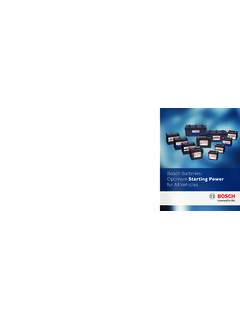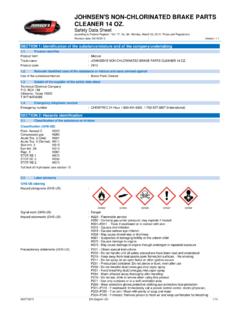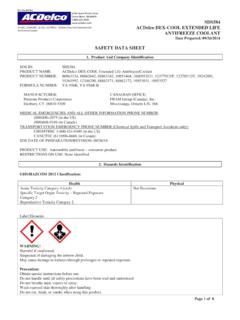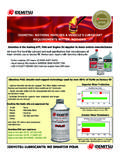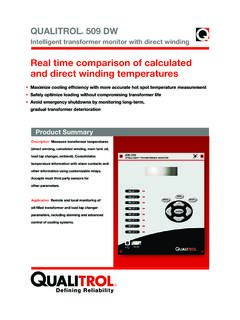Transcription of Material Safety Data Sheet - WORLDPAC
1 Material Safety data Sheet NFPA WHMIS PPE Transport Symbol Non-controlled Not regulated Revision Date: 12-Jul-2010 Revision Number: 0. 1. PRODUCT AND COMPANY IDENTIFICATION. Product Name: Honda Genuine ATF DW-1, 12 x 1 Liter Case Product Code: 1664-L42. Recommended use Automotive Lubricant Contact Manufacturer Idemitsu Lubricants America, 701 Port Rd. Jeffersonville, IN. 47130. Telephone: 812-285-8234. Fax: 812-285-8243. Contact Name: Robin Hutchens Email: Emergency Telephone Number Chemtrec 1-800-424-9300. 2. HAZARDS IDENTIFICATION. CAUTION! Emergency Overview Vapors may be irritating to eyes, nose, throat, and lungs Appearance Red Physical State: Liquid Odor: Mild Mexico - Grade Slight risk, Grade 1. Potential Health Effects Principle Routes of Exposure Skin, Eye Acute Effects Eyes May cause slight irritation Skin Substance may cause slight skin irritation Inhalation May cause irritation of respiratory tract Ingestion May be harmful if swallowed Chronic Effects Prolonged exposure may cause chronic effects _____.
2 Page 1 / 8. 1664-L42 - Honda Genuine ATF DW-1, 12 x 1 Liter Case Revision Date: 12-Jul-2010. _____. See Section 11 for additional Toxicological information. Signs and Symptoms: Vapors and/or aerosols which may be formed at elevated temperatures may be irritating to eyes and respiratory tract Potential Environmental Effects See Section 12 for additional Ecological information. 3. COMPOSITION/INFORMATION ON INGREDIENTS. While this Material is not considered hazardous by the OSHA Hazard Communication Standard (29 CFR ), this MSDS contains valuable information critical to the safe handling and proper use of the product. This MSDS should be retained and available for employees and other users of this product. Hazardous Components Chemical Name CAS-No Weight %. 2,6-Di-tert-butyl-p-cresol 128-37-0 - 1. Non-Hazardous Components Chemical Name CAS-No Weight %. Lubricating Base Stocks Mixture 80-90. 4. FIRST AID MEASURES. General Advice Show this Safety data Sheet to the doctor in attendance.
3 If symptoms persist, call a physician. Eye Contact Rinse immediately with plenty of water, also under the eyelids, for at least 15 minutes. Keep eye wide open while rinsing. If eye irritation persists, consult a specialist. Skin contact Wash off immediately with soap and plenty of water while removing all contaminated clothes and shoes. If skin irritation persists, call a physician. Inhalation Move to fresh air in case of accidental inhalation of vapours or decomposition products. If breathing is difficult, give oxygen. If not breathing, give artificial respiration. If symptoms persist, call a physician. Ingestion Do not induce vomiting without medical advice. If vomiting occurs naturally, have casualty lean forward to reduce the risk of aspiration. Never give anything by mouth to an unconscious person. Call a physician or Poison Control Center immediately. Protection of First-aiders Use personal protective equipment. Avoid contact with skin, eyes and clothing.
4 5. FIRE-FIGHTING MEASURES. Flammable Properties NFPA: Class IIIB Combustible Liquid Suitable Extinguishing Media Use extinguishing measures that are appropriate to local circumstances and the surrounding environment. Hazardous combustion products Carbon oxides, oxides of phosphorus, Zinc oxides, Sulphur oxides , Oxides of Boron, Calcium Oxides ( CaOx). Specific Hazards Arising from the Chemical Keep product and empty container away from heat and sources of ignition _____. Page 2 / 8. 1664-L42 - Honda Genuine ATF DW-1, 12 x 1 Liter Case Revision Date: 12-Jul-2010. _____. Protective Equipment and Precautions for Firefighters As in any fire, wear self-contained breathing apparatus pressure-demand, MSHA/NIOSH (approved or equivalent) and full protective gear NFPA Health: 0 Flammability: 1 Instability: 0. 6. ACCIDENTAL RELEASE MEASURES. Personal Precautions Use personal protective equipment. Avoid breathing vapors or mists. Avoid contact with skin, eyes and clothing.
5 Ensure adequate ventilation. Keep people away from and upwind of spill/leak. Environmental Precautions Prevent further leakage or spillage if safe to do so. Should not be released into the environment. Prevent product from entering drains. Do not flush into surface water or sanitary sewer system. Do not allow Material to contaminate ground water system. Methods for Clean-up Dam up. Soak up with inert absorbent Material . Pick up and transfer to properly labeled containers. Spill Management LARGE SPILLS Eliminate sources of ignition. Prevent additional discharge of Material if possible to do so without hazard. For small spills implement cleanup procedures; for large spills implement cleanup procedures and, if in public area, keep public away and advise authorities. Also, if this product is subject to CERCLA reporting (see Section 15 Regulatory Information) notify the National Response Center. WATER SPILLS Prevent liquid entering sewers, watercourses, or low areas.
6 Contain spilled liquid with sand or earth. Recover by pumping or with suitable absorbent. If liquid is too viscous for pumping, scrape up. Consult an expert on disposal of recovered Material and ensure conformity to local disposal regulations 7. HANDLING AND STORAGE. Handling Wear personal protective equipment. Do not breathe vapors or spray mist. Remove and wash contaminated clothing before re-use. Keep away from open flames, hot surfaces and sources of ignition. Storage Keep in properly labeled containers. Keep container tightly closed in a dry and well-ventilated place. Safe Handling Advice Handle in accordance with good industrial hygiene and Safety practices 8. EXPOSURE CONTROLS / PERSONAL PROTECTION. Exposure Guidelines Hazardous Components Chemical Name ACGIH TLV OSHA PEL Ontario TWAEV Mexico NIOSH IDLH. 2,6-Di-tert-butyl-p-cresol TWA: 2 mg/m3 TWA: 2 mg/m3 STEL: 20 mg/m3. TWA: 10 mg/m3. Chemical Name OSHA PEL ACGIH TLV ACGIH OEL ILA IHG ILA ROEG.
7 (STEL). _____. Page 3 / 8. 1664-L42 - Honda Genuine ATF DW-1, 12 x 1 Liter Case Revision Date: 12-Jul-2010. _____. Oil mist, mineral TWA: 5 mg/m3 TWA: 5 mg/m3 10 mg/m3. STEL: 10 mg/m3. Engineering measures Ensure adequate ventilation, especially in confined areas. Consider the potential hazards of this Material (see Section 2), applicable exposure limits, job activities, and other substances in the work place when designing engineering controls and selecting personal protective equipment. If engineering controls or work practices are not adequate to prevent exposure to harmful levels of this Material , the personal protective equipment listed above is recommended. The user should read and understand all instructions and limitations supplied with the equipment since protection is usually provided for a limited time or under certain circumstances. Personal Protective Equipment Eye/face Protection Safety glasses with side-shields. Skin Protection Wear protective gloves/clothing.
8 Glove Type: Neoprene, Nitriles Respiratory protection If exposure limits are exceeded or irritation is experienced, NIOSH/MSHA approved respiratory protection should be worn. Positive-pressure supplied air respirators may be required for high airborne contaminant concentrations. Respiratory protection must be provided in accordance with current local regulations General Hygiene Considerations When using, do not eat, drink or smoke. Clean equipment, work area and clothing regularly. 9. PHYSICAL AND CHEMICAL PROPERTIES. Appearance Red Odor: Mild Physical State: Liquid Flash Point 170 C / 338 F. Method COC ASTM D92. Density g/cm3@15 C. Viscosity @40C= cSt; @100C = cSt 10. STABILITY AND REACTIVITY. Chemical Stability Stable under recommended storage conditions. Hazardous polymerization does not occur. Conditions to Avoid Heat, flames and sparks Incompatible Materials Strong oxidizing agents Hazardous decomposition products Thermal decomposition can lead to release of irritating gases and vapors 11.
9 TOXICOLOGICAL INFORMATION. Acute Toxicity LD50 Oral: mg/kg LD50 Dermal: mg/kg _____. Page 4 / 8. 1664-L42 - Honda Genuine ATF DW-1, 12 x 1 Liter Case Revision Date: 12-Jul-2010. _____. Hazardous Components Chemical Name LD50 Oral LD50 Dermal LC50 Inhalation 2,6-Di-tert-butyl-p-cresol 890 mg/kg ( Rat ). Chronic Toxicity Carcinogenicity: The table below indicates whether each agency has listed any ingredient as a carcinogen Hazardous Components Chemical Name ACGIH IARC NTP OSHA Mexico 2,6-Di-tert-butyl-p-cresol Group 3 A4 - Not classifiable as a human carcinogen 12. ECOLOGICAL INFORMATION. Ecotoxicity Lubricant oil basestocks are complex mixtures of hydrocarbons (primarily branched chain alkanes and cycloalkanes) ranging in carbon number from C15 to C50. The aromatic hydrocarbon content of these mixtures varies with the severity of the refining process. White oils have negligible levels of aromatic hydrocarbons, whereas significant proportions are found in unrefined basestocks.
10 Olefins are found only at very low concentrations. Volatilization is not significant after release of lubricating oil basestocks to the environment due to the very low vapor pressure of the hydrocarbon constituents. In water, lubricating oil basestocks will float and will spread at a rate that is viscosity dependent. Water solubilities are very low and dispersion occurs mainly from water movement with adsorption by sediment being the major fate process. In soil, lubricating oil basestocks show little mobility and adsorption is the predominant physical process. Both acute and chronic ecotoxicity studies have been conducted on lubricant base oils. Results indicate that the acute aquatic toxicities to fish, Daphnia, Ceriodaphnia and algal species are above 1000 mg/l using either water accommodated fractions or oil in water dispersions. Since lubricant base oils mainly contain hydrocarbons having carbon numbers in the range C15 to C50, it is predicted that acute toxicity would not be observed with these substances due to low water solubility.

